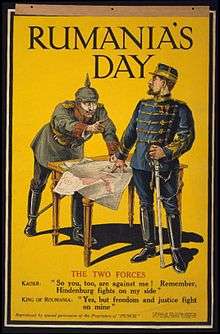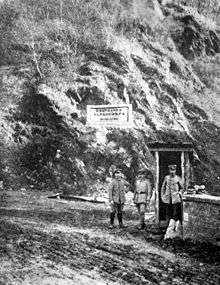Romania during World War I
The Romanian campaign was part of the Balkan theatre of World War I, with Romania and Russia allied against the armies of the Central Powers. Fighting took place from August 1916 to December 1917 across most of present-day Romania, including Transylvania, which was part of the Austro-Hungarian Empire at the time, as well as southern Dobruja, which is currently part of Bulgaria.
Romania entered the war in an attempt to seize Transylvania, a region with significant Romanian population, from the Austro-Hungarian Empire. Despite initial successes, the Romanian forces (aided by Russia) suffered several setbacks, and by the end of 1916 only Moldavia remained under Allied control. After several defensive victories in 1917, with Russia's withdrawal from the war following the October Revolution, Romania, almost completely surrounded by the Central Powers, was also forced to drop out of the war; it signed the Treaty of Bucharest with the Central Powers in May 1918. On 10 November 1918, just one day before the German armistice and after all the other Central Powers had already capitulated, Romania re-entered the war. By then, about 220,000 Romanian soldiers had been killed, about 6% of total Entente military deaths.
Before the war
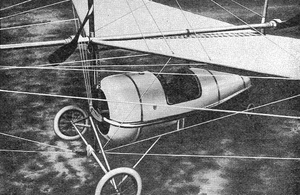
The Kingdom of Romania was ruled by kings of the House of Hohenzollern from 1866. In 1883, the King of Romania, Carol I of Hohenzollern, signed a secret treaty with the Triple Alliance that stipulated Romania's obligation to go to war only in the event that Austro-Hungarian Empire was attacked. While Carol wanted to enter World War I as an ally of the Central Powers, the Romanian public and the political parties were in favor of joining the Triple Entente. Romania remained neutral when the war started, arguing that Austria-Hungary itself had started the war and, consequently, Romania was under no formal obligation to join it.[18][19]
In return for entering the war on Allied side, the Romania demanded support for its territorial claims to parts of Transylvania, an Austro-Hungarian territory with a Romanian majority. The Romanians' greatest concerns in negotiations were the avoidance of a conflict that would have to be fought on two fronts (one in Dobruja with Bulgaria and one in Transylvania) and written guarantees of Romanian territorial gains after the war. They demanded an agreement not to make separate peace with the Central Powers, equal status at the future peace conference, Russian military assistance against Bulgaria, an Allied offensive in the direction of Bulgaria, and the regular shipment of Allied war supplies. The military convention they signed with the Allies stipulated that France and Britain should start an offensive against Bulgaria and the Ottoman Empire no later than August 1916, that Russia would send troops into Dobruja, and that the Romanian army would not be subordinated to Russian command. The Allies were to send 300 tons of provisions on a daily basis. According to the Romanian account, most of these clauses, with the exception of those imposed on Romania, failed to be respected.[20]
The Allies accepted the terms late in the summer of 1916 (see Treaty of Bucharest, 1916); Cyril Falls attributes the late decision to Romania's historical hostility towards the Russian Empire and purports that an earlier entry into the war, perhaps before the Brusilov Offensive the same year, would have provided better chance for victory.[21] According to some American military historians, Russia delayed approval of Romanian demands out of worries about Romanian territorial designs on Bessarabia, claimed by nationalist circles as a Romanian land.[22] According to British military historian John Keegan, before Romania entered the war, the Allies had secretly agreed not to honour the territorial expansion of Romania when the war ended.[23]

In 1915, Lieutenant-Colonel Christopher Thomson, a fluent speaker of French, was sent to Bucharest as British military attaché on the initiative of Lord Kitchener to bring Romania into the war. Once there, he quickly formed the view that an unprepared and ill-armed Romania facing a war on two fronts would be a liability, not an asset, to the Allies. This view was brushed aside by Whitehall, and Thomson signed a Military Convention with Romania on 13 August 1916. Within a few months, he had to alleviate the consequences of Romania’s setbacks and supervise the destruction of the Romanian oil wells to deny them to Germany.[24]
The Romanian government signed a treaty with the Allies (France, Britain, Italy and Russia) on 17 August 1916 that pledged to declare war on Austria-Hungary by 28 August. The Romanian ambassador in Vienna actually transmitted the declaration of war on 27 August. Germany, caught by surprise, responded with a declaration of war on Romania the next day (28 August). The dates of the Bulgarian and Ottoman declarations of war are disputed. Ian Beckett says that Bulgaria did not issue a declaration of war prior to its attack of 31 August.[25] Other sources place the declaration on 30 August[26] or 1 September.[27][28] The Ottoman declaration took place either on 29 August,[26] 30 August[27] or 1 September.[28] Within two days of her own declaration, according to one source, Romania found herself at war with all the Central Powers.[29]
The Romanian army was quite large, with over 650,000 men in 23 divisions, but it suffered from poor training and equipment, particularly when compared to its German counterparts. Meanwhile, the German Chief of Staff, General Erich von Falkenhayn, had correctly reasoned that Romania would side with the Allies, and had made plans accordingly. Thanks to the earlier conquest of the Kingdom of Serbia and the ineffective Allied operations on the Kingdom of Greece border, and having a territorial interest in Dobruja, the Bulgarian Army and the Ottoman Army were willing to help fight the Romanians.
The German high command was seriously worried about the prospect of Romania entering the war, Hindenburg writing:
It is certain that so relatively small a state as Rumania had never before been given a role so important, and, indeed, so decisive for the history of the world at so favorable a moment. Never before had two great Powers like Germany and Austria found themselves so much at the mercy of the military resources of a country which had scarcely one twentieth of the population of the two great states. Judging by the military situation, it was to be expected that Rumania had only to advance where she wished to decide the world war in favor of those Powers which had been hurling themselves at us in vain for years. Thus everything seemed to depend on whether Rumania was ready to make any sort of use of her momentary advantage.[30]
Romanians in the Austro-Hungarian Army
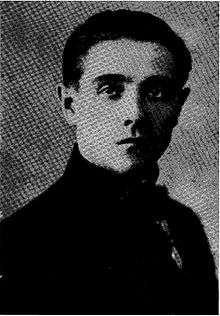
The Romanians in Austria-Hungary entered the war from the very beginning, with hundreds of thousands of Transylvanian and Bukovinian Romanians being mobilized throughout the war. Romanian troops fought on all European fronts of the Dual Monarchy, some of them being distinguished, such as Hauptmann (Căpitan) Gheorghe Flondor and Leutnant (Locotenent) Emil Rebreanu. Other notable Romanians who fought in the Austro-Hungarian Army included Oberleutnant (Locotenent-Major) and Imperial Adviser Constantin Isopescu-Grecul, as well as Octavian Codru Tăslăuanu, who also wrote valuable memoirs about his war experience. Samoilă Mârza, a Private (Soldat) in the Austro-Hungarian Army, reached as far as Riga and became the first Romanian war photographer. In total, up to 150,000 Romanians were killed in action while fighting as part of the Austro-Hungarian Army.[31]
Course of the Romanian campaign
Romanians!
The war which for the last two years has been encircling our frontiers more and more closely has shaken the ancient foundations of Europe to their depths.
It has brought the day which has been awaited for centuries by the national conscience, by the founders of the Romanian State, by those who united the principalities in the war of independence, by those responsible for the national renaissance.
It is the day of the union of all branches of our nation. Today we are able to complete the task of our forefathers and to establish forever that which Michael the Great was only able to establish for a moment, namely, a Romanian union on both slopes of the Carpathians.
For us the mountains and plains of Bukowina, where Stephen the Great has slept for centuries. In our moral energy and our valour lie the means of giving him back his birthright of a great and free Rumania from the Tisza to the Black Sea, and to prosper in peace in accordance with our customs and our hopes and dreams.
Romanians!
Animated by the holy duty imposed upon us, and determined to bear manfully all the sacrifices inseparable from an arduous war, we will march into battle with the irresistible élan of a people firmly confident in its destiny. The glorious fruits of victory shall be our reward. Forward, with the help of God!
FERDINAND
Proclamation by King Ferdinand, 28 August 1916[32]
On the night of August 27, 1916, three Romanian armies (First, Second and Northern Army), deployed according to the Romanian Campaign Plan (The "Z" Hypothesis), launched the Battle of Transylvania through the Carpathians.[33] Initially, the only opposing force was the Austro-Hungarian First Army, which was steadily pushed back toward Hungary. In a short time, the towns of Brașov, Făgăraș and Miercurea Ciuc were captured, and the outskirts of Sibiu were reached. In areas populated with Romanians, the Romanian troops were warmly welcomed, and the locals provided them considerable assistance in terms of provisions, billeting and guiding.[34] However, the rapid Romanian advance alarmed the Central Powers, and within weeks sizable reinforcements began arriving at the scene. The Entente incorrectly assumed that Germany would be unable to respond to the invasion, as the Battle of the Somme and the Brusilov Offensive were at their height around this time and tied down significant German forces. Nevertheless, eight divisions and an Alpine Corps were deployed under the command of Erich von Falkenhayn. The Austro-Hungarians also sent four divisions to reinforce their lines, and by the middle of September, the Romanian offensive was halted. The Russians loaned them three divisions for operations in the north of Romania, but hampered their efforts by failing to provide much-needed supplies.
While the Romanian Army was advancing in Transylvania, the first counterattack came from Field Marshal August von Mackensen in command of a multi-national force composed of the Bulgarian Third Army, a German brigade and two divisions of the Ottoman VI Army Corps, whose units began arriving on the Dobrudja front after the initial battles.[35] This army attacked north from Bulgaria, starting on September 1. It stayed on the south side of the Danube river and headed towards Constanța. The Romanian garrison of Turtucaia, encircled by Bulgarian troops (aided by a column of German troops) surrendered on September 6 at the conclusion of the Battle of Turtucaia. The Romanian Third Army made further attempts to withstand the enemy offensive at Silistra, Dobrich, Amzacea and Topraisar, but had to withdraw under the pressure of superior enemy forces. Mackensen's success was favoured by the failure of the Allies to fulfill the obligation they had assumed through the military convention, by virtue of which they had to mount an offensive on the Macedonian front and the conditions in which the Russians deployed insufficient troops on the battlefront in the south-east of Romania. These factors meant that the Romanian forces became too strained to put up effective resistance against the enemy advance. Romania had to fight on two 1,600 km-long battlefronts, the longest front in Europe, with a varied configuration and diverse geographical elements (by comparison, the Russian front, stretching from the Baltic Sea to Bukovina, was only 1,000 km long).[36]

On September 15, the Romanian War Council decided to suspend the Transylvania offensive and concentrate on the Mackensen army group instead. The plan (the so-called Flămânda Offensive) was to attack the Central Powers forces from the rear by crossing the Danube at Flămânda, while the front-line Romanian and Russian forces were supposed to launch an offensive southwards towards Cobadin and Kurtbunar. Russian reinforcements under General Andrei Zaionchkovsky arrived to halt Mackensen's army before it cut the rail line that linked Constanța with Bucharest. Fighting was furious, with attacks and counterattacks until September 23. The Bulgarian Third Army suffered a tactical defeat in the First Battle of Cobadin on September 19, forcing the Central Powers to halt their advance until mid-October. On October 1, two Romanian divisions crossed the Danube at Flămânda and created a bridgehead 14 kilometer-wide and 4 kilometer-deep. On the next day, this area was expanded, with 8 Bulgarian settlements ending up in Romanian hands. However, due to the deteriorating situation in Transylvania, the offensive was cancelled on 3 October. The Austro-Hungarian river monitors Bodrog and Körös together with the patrol boat Barsch were damaged.
The counteroffensive of the Central Powers
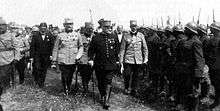
Overall command was now under Erich von Falkenhayn (recently replaced as German Chief of Staff), who started his own counterattack on 18 September. The first attack was on the Romanian First Army near the town of Hațeg; the attack halted the Romanian advance. Eight days later, German troops attacked Sibiu, and on 29 September, the outnumbered Romanians began retreating to the Vulcan and Turnu Roșu Passes. The latter, however, had been occupied by Bavarian mountain troops in a flanking movement, and the Battle of Turnu Roșu Pass ended with the Romanians retaking the pass at a cost of 3,000 men. On October 17, the Romanian Second Army attacked the Austro-Hungarians at Brașov, but the attack was repulsed and the counterattack forced the Romanians to retreat from there also. The Romanian Fourth Army, in the north of the country, retreated without much pressure from the Austro-Hungarian troops, so that by 25 October, the Romanian army was back to its initial positions.[37] The Central Powers succeeded in taking the strategic initiative in Transylvania by concentrating significant military forces rapidly brought in from the other theatres of operations in Europe and exploiting a quick shift of Romanian units to the battlefront in Dobruja.[36]
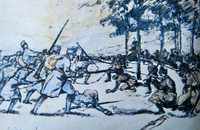
In October 1916, the Romanian army mounted a wide-scale operation, the main target of which was the defense of the mountain passes in the Southern and Eastern Carpathians against the ever-stronger pressure of the German and Austro-Hungarian forces. Grim fights erupted in the Prahova Valley, where occupation of the locality of Predeal was one of the major aims pursued by the Central Powers. Given their dramatic character, the clashes for the Predeal town and railway station were frequently compared with the heaviest fights on the Western Front. Similar fights took place in the Bran-Câmpulung area, especially at Dragoslavele and Racoș.[36]
Particular heed was paid to the actions carried on for the defense of the Carpathians' alignment, the fights on the Jiu River. There, the Germans had massed large forces to beat their way south of the mountains. Faced with the enemy threat, the troops of the Romanian First Army, under command of General Ion Dragalina, offered strong resistance. The Romanian soldiers were supported everywhere by the civil population; during the Battle of Târgu Jiu, the town was defended by its inhabitants, men, women and children, young and old. There, a conspicuous figure was cut by Ecaterina Teodoroiu, who was to enter the consciousness of all Romanians as the "Heroine of the Jiu". The operation for the defense of the Carpathians holds a prominent place in Romanian military history not only because it was one of the most difficult operations waged by the Romanian army until then, but also because it was one of the most important as regards the complexity of the actions carried on and the highly valuable lessons derived from their evolution.[36]

After the Romanian troops were initially able to stop the German advance on the Jiu Valley, the German army regrouped on 29 October 1916. The German High Command created the Army Group Kühne, headquartered in Petroșani, under the command of General Viktor Kühne. This Army Group included the 11th and 301st Bavarian infantry divisions, which had previously fought the Romanians on the Jiu, the 41st Prussian and the 109th infantry divisions which were transferred from the Riga front as well as the newly formed 58th Cavalry Corps (z.b.V) under the command of general Egon von Schmettow, which included the 6th and 7th cavalry divisions. The German reserves consisted of the 115th infantry division and two brigades of cyclists. The total manpower of the Army Group amounted to 80,000 troops with 30,000 horses. The Romanian forces could not withstand the new German attack which started on 1 November 1916. The Romanians retreated and on 21 November 1916 the German cavalry entered Craiova. The Romanian army continued its retreat towards the Olt River while the cavalry tried to slow the German advance in order to give it time to organize a defensive line along the Olt. Although the Romanian army made attempts to stop the advance of the German forces, such as in the Battle of Robănești, these were largely unsuccessful.[38]
Back on the coast, Field Marshal Mackensen and Bulgarian General Stefan Toshev launched a new offensive on 19 October, after a month of careful preparations, and achieved a decisive victory in the Second Battle of Cobadin. The Romanians and Russians were forced to withdraw out of Constanța (occupied by the Central Powers on 22 October). After the fall of Cernavodă, the defense of the unoccupied Dobruja was left only to the Russians, who were gradually pushed back towards the marshy Danube Delta. The Russian Army was now both demoralized and nearly out of supplies. Mackensen felt free to secretly pull a large number of troops back to the town of Svishtov in Bulgaria with an eye towards crossing the Danube river.
In mid-November, after several tactical defeats in the Southern Carpathians (Bran-Câmpulung, Prahova Valley, Jiu Valley) Falkenhayn concentrated his best troops (the elite Alpen Korps) in the south for an attack on the Vulcan Pass. The Battle of Vulcan Pass was launched on 10 November. One of the young officers was the future Field Marshal Erwin Rommel. On 11 November, then-Lieutenant Rommel led the Württemberg Mountain Company in the capture of Mount Lescului. The offensive pushed the Romanian defenders back through the mountains and into the plains by 26 November. There was already snow covering the mountains and soon operations would have to halt for the winter. Advances by other parts of Falkenhayn's Ninth Army also pushed through the mountains; the Romanian army was being ground down by the constant battle and their supply situation was becoming critical.
In the Black Sea, the German submarine UC-15 was lost while laying mines near the Romanian port of Sulina, most likely sunk by her own mines.[39][40][41]
On 23 November, Mackensen's best troops crossed the Danube at two locations near Svishtov. This attack caught the Romanians by surprise and Mackensen's army was able to advance rapidly towards Bucharest against very weak resistance. Mackensen's attack threatened to cut off half the Romanian army. In response, the Romanian Command prepared a counter-offensive known under the name of the Battle of the Argeş (part of the Battle of Bucharest) and designated the recently promoted General Constantin Prezan to lead it. The plan envisaged the checking of the advance of the German Ninth Army from the north and north-west, as well as the encirclement and annihilation of the German-Bulgarian-Turkish units deployed south-east of Bucharest.[42] It was a bold undertaking, using the entire reserves of the Romanian army, but it needed the cooperation of Russian divisions to contain Mackensen's offensive while the Romanian reserve struck the gap between Mackensen and Falkenhayn. However, the Russian army would not endorse the plan and did not support the attack.
On 1 December, the Romanian army went ahead with the offensive along the Argeș and Neajlov rivers. Initially, the Romanians experienced success, taking a large number of prisoners, however Mackensen was able to shift forces to deal with the sudden assault and Falkenhayn's forces responded with attacks at every point.[43] Faced with the overwhelming superiority of the invading forces, the Romanian army, its ranks thinned from the previous actions, inferior in equipment and lacking Russian support, failed to check the enemy advance. Although it recorded numerous daring actions (among these the Prunaru Charge, in which the 2nd Roşiori Cavalry Regiment was almost wiped out), the Battle of Argeş ended unfavourably for the Romanian army.[42] Within three days, the attack had been shattered and the Romanians were retreating everywhere. Bucharest was captured on 6 December by Falkenhayn's cavalry. The Romanian Second Army made a fighting retreat to the Siret river, which had originally been fortified against the Russians and was facing the wrong direction, but nevertheless would end up proving invaluable, protected as it was by the impassable Danube Delta to the southeast and a flank in the Carpathians in the northwest. Fierce fighting took place in the Battle of Râmnicu Sărat between 22 and 26 December, with Mackensen's forces entering the town on 27 December. Around this time, the Russians began sending numerous reinforcements to Moldavia to prevent an invasion of southern Russia. Southern Romania, including Oltenia, Muntenia, Dobruja and southern Moldavia, was now in the hands of the Central Powers. While retreating, the Romanians burnt stores of grain and destroyed oil wells to prevent them from being used by the Germans.[42]
On 3 December, the Romanian river torpedo boat Căpitan Valter Mărăcineanu was sunk on the Danube by a mine.[44][45]
The remaining Russo-Romanian forces in Dobruja abandoned Măcin on 4 January 1917 and Brăila on 5 January 1917. Toward the end of the month, extreme frost gave the Bulgarians an opportunity to enter the Danube Delta. On 23 January, they attempted to cross the marshes at Tulcea, but suffered heavy casualties to Romanian defenders on the northern bank and stopped. The Romanian Land Forces, supported by the Danube Division of the Romanian Navy and by the actions of the Romanian cruiser Elisabeta at the mouths of the Danube, managed to prevent the Central Powers from advancing into the Danube Delta, keeping it under Romanian control until the end of the War.[46][47] Fighting also ceased in the Carpathian passes, also owing to unfavorable weather. Mackensen's troops were able to capture Focșani on 8 January, but an attempt to break the Siret River line on 19 January failed. Thus, the front stabilized and allowed for the Romanian army to be refitted and rebuilt.
Romania entered the war at a time of strong crisis for the Entente, drawing upon itself numerous enemy forces, fighting on a very long battlefront and having to change its initial campaign plan permanently. But in spite of the human, material and military efforts made by the Central Powers throughout this period, they failed to achieve their fundamental political and strategic goal to defeat Romania and knock it out of the war. Despite heavy casualties, some 250,000 men (almost one third of the manpower mobilized in August 1916), and losses of combat material, the Romanian army was still a force taken into consideration by allies and enemies alike and capable of offering resistance to further attacks. Part of the population moved to the free territory, together with the Romanian government, royal court and public authorities, which relocated to Iași. Therefore, the Kingdom of Romania continued to exercise the attributes of an independent and sovereign state, allied to the Entente powers.[42]
Romanian recovery
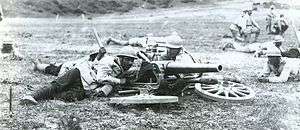
In 1917, when both belligerent sides were making huge efforts to win the final victory, for Romania it was vitally important for Romanians to expel the occupying forces, since the existence of the Romanian state depended on it. After the Romanian troops had managed to bring the enemy to a halt at Moldavia's Gates, on the Eastern Carpathians, the Siret River and the Danube Delta alignment in cooperation with Russian military forces, Romania embarked on the reconstruction and strengthening of its combat capability during the first half of 1917 through multiple national efforts under highly complex international circumstances. Considerable measures were taken in all economic branches to rebuild the evacuated factories and workshops, increase the production destined for the national defense and the productivity yielded by the exploitation of the few petroleum and coal resources in the free zones. Agriculture received special attention to help meet basic nutritional needs and ensure a minimal living standard to the population in the free part of the country, and also to assist the refugees who had left their houses in front of the enemy invasion, the Romanian army and the Russian troops (who numbered about one million by early 1917).[48]
With a view to achieving the unity of action of internal political forces that was indispensable to safeguarding the nation's interests, a government of national union was set up in Iaşi on 24 December 1916, led by Ion I. C. Brătianu. The political life in unoccupied territory adopted a fundamental goal to achieve national consensus to find the means to conclude a successful liberation war. Within this framework, debates on some laws envisaging structural transformations (primarily the agrarian reform to re-allocate land to peasants and the introduction of universal suffrage) responded to popular demands of the citizenry and contributed to the morale of the soldiers in the front lines.[48]
The Romanian army's reconstruction involved both re-organization and modernization. While the forces that had taken part in the big Battle of Bucharest (Army Group Prezan) were reshuffled inland, the Romanian Second Army, which had preserved to a great extent its combat structures and force to a great extent, remained on the front in southern Moldavia, where, alongside Russian forces, it checked the enemy advance. The reorganization was initiated by King Ferdinand and the Romanian government. It was carried on under their leadership and control in the free national territory, in spite of Russian attempts to shift the Romanian army beyond the Dniester, inside Ukraine. The re-organization pursued the reduction of the effectives of the "Operations Army" to parameters that suited the country's resources for waging a long campaign. The infantry divisions were ensured identical structure to make replacements and maneuvers easier on the battlefront and to have a fire power comparable with that of the enemy. The army corps became only a command body for tactical coordination. The cavalry divisions received more machine guns. The artillery material underwent a homogenization process, with two regiments (one cannon, the other howitzer) for each division, while the heavy artillery was organized as a distinct group.[49]
The re-organization also involved the other troops (combat engineers, air force, navy) and services, which underwent notable improvements. The directions, organization and methodology of the training of the command staff and the troops were considerably improved and special training centers were set up. Priority was given to trench warfare, the assimilation of new military technology and night combat.[50]
Considerable progress was achieved with the technical-material equipment of the army by means of its provisioning with armament, ammunition and other combat resources from inside the country, but even more importantly from abroad. The Allies supported the maintenance of the Romanian front by continuing to deliver and supplement previously placed orders.[50] 150,000 French 8 mm rifles, 1,760 Hotchkiss M1914 machine guns, 197 Vickers machine guns, 2,628 Chauchats, 108 Lewis guns, 1,3 million F1 grenades, 84 Puteaux 75mm guns, 72 long and 20 short de Bange 120 mm guns, 28 Coventry 127 mm howitzers, 14 St. Chamond 155 mm and seven Schneider-Putilov 152,4 mm howitzers and 130 French 58mm trench mortars arrived from Western Europe.[51] In parallel, efforts were made to meet the food and health care needs and special heed was paid to strengthening the soldiers' morale. A notable contribution to the reconstruction of the Romanian army was made by the 1,600-strong French military mission led by General Henri Mathias Berthelot, which supervised the process and helped retrain Romanian troops. In early June 1917, the Romanian army's strength grew to about 700,000 men, organized in 207 infantry battalions plus 60 march battalions, 110 cavalry squadrons and 245 artillery batteries, divided among two armies and five corps. The results obtained in terms of re-organization and recovery impressed public opinion both at home and abroad and were to be confirmed in the great battles of the ensuing months.[50]
On 16 April 1917, the Romanian torpedo boat Smeul was sunk by a mine near Sulina.
1917 campaign and armistice
Aware of the complex strategic situation, the Romanian Command lent its military policy a clear, realistic orientation of committing the entire population to battle, trying to act efficiently in keeping with the national goals and in harmony with the large-scale operations worked out at the coalition level. Its final form ready in late May 1917, the operations plan for the Romanian front called for the mounting of a general offensive in the Focşani-Nămoloasa sector with a view to completely pin down all enemy forces there, annihilate the main enemy groups operating there (the German Ninth Army) and support the Kerensky Offensive.[52] The decisive effort was to be made by the Romanian First Army. In order to increase the effect of the offensive and draw as many enemy troops as possible northwest of the town of Focşani, the actions of the Romanian Second and Russian Fourth Armies had to precede those of the Romanian First Army. The German High Command, which had moved the center of gravity of its military operations to the Eastern Front in hopes of winning a victory there through the defeat of Romania and the conclusion of a peace with Russia, decided in June 1917 to mount a wide-scope offensive in the north and south of Moldavia, to which end it brought over reinforcements from the other fronts.[53]
In early July 1917, on the Romanian front, one of the largest concentrations of combat forces and war materiel assembled during World War I: nine armies, 80 infantry divisions with 974 battalions, 19 cavalry divisions with 550 squadrons and 923 artillery batteries, whose effectives amounted to some 800,000 men, with about one million in their immediate reserve. The three great battles, decisive for the Romanian nation's destiny, delivered at Mărăști, Mărășești and Oituz, represented a turning point in the war on the Eastern front. These battles were fought approximately on the front alignment stabilized in early 1917, which the conflicting sides had thoroughly consolidated for half a year.[54]
The Battle of Mărăști began on 24 July 1917 at dawn, and took place in Vrancea County in the sector of the Romanian Second and Russian Fourth Armies. Initiated by surprise with three divisions, the offensive succeeded in disrupting the well-organized enemy defenses and compelling the Austro-Hungarians and Germans to retreat. By the evening, the Romanian divisions had conquered the first defenses, the strongest and deepest of the defensive system of the Gerok Group of the Austro-Hungarian First Army) in the Mărăști area. The next day, pursuing the offensive, the Romanian troops forced the enemy into an ever more disorderly retreat. This created favorable conditions for a deep penetration into the defensive disposition and the annihilation of the enemy group. However, under the circumstances in which the Russian High Command decided unilaterally to stall any offensive as a result of the grave situation created on the front in Galicia and Bukovina following the failure of the Kerensky Offensive and the counter-attack of the Central Powers, the Romanian General Headquarters saw itself compelled to discontinue the offensive throughout the entire territory between the Eastern Carpathians and the Black Sea. In the Mărăști zone, however, the Romanian units continued the offensive until July 30 upon the request of their commander, General Alexandru Averescu. This marked the end of the Battle of Mărăști. It inflicted important losses upon the Austro-Hungarians and Germans, who relinquished a 35 km-wide and 20 km-deep area and sustained heavy casualties and losses in combat resources. The offensive potential of the Romanian army was confirmed through this victory.[54]
The salient created by the Romanian troops in the enemy lines at the junction between the Austro-Hungarian First Army and the German Ninth Army made the High Command of the Central Powers bring forces from other sectors on the Moldavian front and change the main direction of the offensive initially planned for the Focşani-Nămoloasa region. After the Mărăști operation had been discontinued, the Central Powers tried to implement their offensive plan in the summer of 1917. They pursued to encircle and smash the Romanian and Russian forces through a blow dealt to the northwest in the direction of Focşani, Mărășești and Adjud, conjugated with another blow that had to start from the mountains through the Oituz and Trotuș valleys towards Târgu Ocna and Adjud (the Second Battle of Oituz). Pursuing the offensive, the German troops aimed at occupying the whole of Moldavia, thereby knocking Romania out of the war, and, together with an in-depth penetration of the Austro-Hungarian troops on the front in Bukovina, to push the Russian forces eastwards, beyond Odessa. The offensive of the German Ninth Army, from the Army Group Mackensen, started on 6 August 1917, when the units of the Russian Fourth Army on the Siret River were expected to leave their positions to reinforce the front in the north of Moldavia and be replaced by the divisions of the Romanian First Army (commanded by General Constantin Cristescu until 12 August, then by General Eremia Grigorescu).[55]
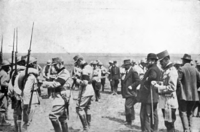
For 29 days, until 3 September, this sector was the scene of the most important battle fought by the Romanian army during the 1917 campaign. The Battle of Mărășești had three distinct stages. During the first stage (6-12 August), the troops of the Romanian First Army, together with Russian forces, managed to arrest the enemy advance and forced the Germans to change the direction of their attack toward the northwest gradually. In the second stage (13-19 August), the Romanian Command completely took over the command of the battle from the Russians. The confrontation reached its climax on August 19, with the result that enemy's attempts to advance were completely thwarted. The third stage (20 August - 3 September) actually saw the last German attempt at least to improve their positions in view of a new offensive, this one also confounded by the Romanian response.[56]
Starting on 8 August 1917, the fighting on the Mărășești front combined with an Austro-Hungarian-German offensive at Oituz. Holding out against superior enemy forces, the Romanian troops by 30 August stemmed the advance of the Gerok Group. The definitive cessation of the general offensive on the Romanian front by the Central Powers on 3 September 1917 marked a strategic defeat and a considerable weakening of their forces on the South-Eastern front. The response of the Romanian army in fact created the strongest blow to the Central Powers that was dealt in Eastern Europe in 1917.[56]
As a result of these operations, the remaining Romanian territories remained unoccupied. Nearly 1,000,000 Central Powers troops were tied down, and The Times was prompted to describe the Romanian front as "The only point of light in the East".
On 22 September, Romania achieved its greatest naval success of the war, when the Austro-Hungarian river monitor SMS Inn struck a Romanian mine and sank near Brăila.[57][58][59]
The situation, however, once again took a turn for the worse for the Entente in November 1917 with the October Revolution in Russia and the beginning of the Russian Civil War. These events effectively ended Russian involvement in the war and left Romania isolated and surrounded by the Central Powers. It had little choice but to negotiate the Focsani Armistice, signed by the combatants on 9 December 1917.
Aftermath
Treaty of Bucharest
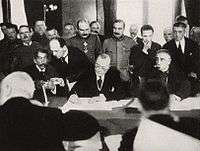
On 7 May 1918, in light of the existing politico-military situation, Romania was forced to conclude the Treaty of Bucharest with the Central Powers. It imposed harsh conditions on the country, but recognized its union with Bessarabia. Alexandru Marghiloman became the new German-sponsored prime minister. King Ferdinand, however, refused to sign the treaty.
The Germans were able to repair the oil fields around Ploiești and by the end of the war had pumped a million tons of oil. They also requisitioned two million tons of grain from Romanian farmers. These materials were vital in keeping Germany in the war to the end of 1918.[60]
Romania reenters the war, November 1918
After the successful offensive on the Thessaloniki front that knocked Bulgaria out of World War I in the autumn of 1918, Romania re-entered the war as of 10 November 1918, the day before it ended in Western Europe.
On 28 November 1918, the Romanian representatives of Bukovina voted for union with the Kingdom of Romania, followed by the proclamation of a Union of Transylvania with Romania on 1 December 1918 by the representatives of Transylvanian Romanians gathered at Alba Iulia, while the representatives of the Transylvanian Saxons approved the act on 15 December at an assembly in Mediaș. A similar gathering was held by the minority Hungarians in Cluj, on 22 December. They reaffirmed their allegiance to Hungary.
The Treaty of Versailles recognized these proclamations under the right of national self-determination espoused in the Fourteen Points of Woodrow Wilson. Germany agreed under the terms of the same treaty (Article 259) to renounce the benefits provided by the Treaty of Bucharest in 1918.[61]
The Romanian control of Transylvania, which had also a minority Hungarian-speaking population of 1,662,000 (31.6%, according to the census data of 1910), was widely resented in the new nation state of Hungary. This started the Hungarian-Romanian War of 1919 between the Romania and the Hungarian Soviet Republic, which also waged parallel conflicts with Czechoslovakia and the Kingdom of Serbs, Croats and Slovenes. The conflict with Romania ended with a partial Romanian occupation of Hungary. The Romanian army left weapons[62] acquired by the army of Admiral Horthy, who became the regent of Hungary after the Romanian troops left Hungary in early 1920.
Military analysis of the campaign

The 1916 counteroffensive was mainly led by the German generals Falkenhayn and Mackensen.[63] Despite this the Germans represented only 22% of the Central Power's forces that took part in the campaign compared to the Austro-Hungarian 46% and combined Bulgarian and Ottoman 32%.[64]
The Romanian offensive in Transylvania failed mainly due to Bulgaria's attack against Dobruja, which opened a new front that strained too much the Romanian Army, already fighting on a very large front. Even though Transylvania was relatively quickly re-taken by the combined German-Austro-Hungarian forces, they failed to initially break the Romanian front in the Carpathians, especially in the Prahova Valley, where a successful breakthrough could lead to the quick capture of Bucharest, cutting off the Romanian Army and forcing the country out of the war. Initial Romanian defensive successes were however short-lived, as the sheer length of the front (1600 km) combined with Central Powers reinforcements eventually forced them to withdraw behind the Siret, in Moldavia. There, despite their precarious situation, they managed to reform, retrain and resupply their Army, which resulted in them winning the greatest victories for the Allies on the European Front in 1917. Despite that, however, they had no choice but to surrender, after being left alone on the Eastern front following Russia's own surrender and being nearly completely surrounded by the Central Powers.
The failure of the Romanian front for the Entente was also the result of several factors beyond Romania's control. The failed Salonika Offensive did not meet the expectation of Romania's "guaranteed security" from Bulgaria.[65] This proved to be a critical strain on Romania's ability to wage a successful offensive in Transylvania, as it needed to divert troops south to the defense of Dobruja.[66] Furthermore, Russian reinforcements in Romania did not materialize to the number of 200,000 soldiers initially demanded.[67] Romania was thus placed in a difficult situation several months after it joined the war, with the Entente unable to provide the support it had promised earlier. All of these amounted to a costly stalemate, instead of the "decisive deathblow" to the Austro-Hungarian Empire that the Entente had expected.
 Romanian invasion of Austria-Hungary, August 1916
Romanian invasion of Austria-Hungary, August 1916 Central Powers counterattack, September–October 1916
Central Powers counterattack, September–October 1916 Operations in Romania, November 1916 to January 1917
Operations in Romania, November 1916 to January 1917
See also
References
- ↑ Serbian volunteers on the Dobruja Front (Romanian)
- ↑ King's Complete History of the World War: 1914-1918. History Associates, Springfield, Massachusetts, 1922 (page 254) https://archive.org/stream/kingscompletehi00kinggoog#page/n260/mode/2up
- ↑ Министерство на войната, Щаб на войската, Българската армия в Световната война 1915 - 1918, Vol. VIII, Държавна печатница, Sofia, 1939
- ↑ Българската армия в Световната война 1915 - 1918, Millions of mouths died in Romania during the Great War. vol. VIII , pag.283
- ↑ turkeyswar, Campaigns, Macedonia front.
- ↑ România în războiul mondial (1916-1919), vol. I, pag. 58
- ↑ http://forum.axishistory.com/viewtopic.php?f=31&t=6905
- ↑ Michael B. Barrett, Prelude to Blitzkrieg: The 1916 Austro-German Campaign in Romania, p. 295
- ↑ Unde nu se trece (Romanian)
- ↑ Michael B. Barrett, Prelude to Blitzkrieg: The 1916 Austro-German Campaign in Romania, pp. 55, 139, 216, 221, 222, 223
- ↑ Министерство на войната (1939), pp. 677 (in Bulgarian)
- ↑ Симеонов, Радослав, Величка Михайлова и Донка Василева. Добричката епопея. Историко-библиографски справочник, Добрич 2006, с. 181 (in Bulgarian
- ↑ Министерство на войната (1943), pp. 390-395 and 870-873
- ↑ Erickson, Edward J. Ordered to die : a history of the Ottoman army in the first World War, pg. 147
- ↑ Cox, Michael; Ellis, John (2001). The World War I Databook: The Essential Facts and Figures for all the Combatants. London: Aurum Press.
- ↑ Tucker, Spencer C; Roberts, Priscilla Mary (2005), Encyclopedia of World War I, Santa Barbara: ABC-Clio, p. 273, ISBN 1-85109-420-2, OCLC 61247250
- ↑ Erlikman, Vadim (2004). Poteri narodonaseleniia v XX veke : spravochnik. Moscow. ISBN 978-5-93165-107-1. p. 51
- ↑ Hentea, Călin (2007). Brief Romanian Military History. Scarecrow Press. p. 102. ISBN 9780810858206. Retrieved 2014-03-02.
- ↑ Becker, Jean-Jacques (2012-01-30). "Chapter Fourteen: War Aims and Neutrality". In Horne, John. A Companion to World War I. Blackwell Publishing. p. 208. ISBN 9781405123860. Retrieved 2014-03-02.
- ↑ Marcel Mitrasca, Moldova: A Romanian Province under Russian Rule. Diplomatic History from the Archives of the Great Powers, pg. 56
- ↑ Cyril Falls, The Great War p. 228
- ↑ Vincent Esposito, Atlas of American Wars, Vol 2, text for map 37
- ↑ John Keegan, The First World War, pg. 306
- ↑ To Ride the Storm: The Story of the Airship R.101 by Sir Peter G. Masefield, pages 16-17 (1982, William Kimber, London) ISBN 0-7183-0068-8
- ↑ Ian F. W. Beckett, The Great War: 1914–1918, 2nd ed. (New York: Routledge, 2013), 109.
- 1 2 Zlata Filipovic and Melanie Challenger, Stolen Voices: Young People's War Diaries, From World War I to Iraq (Doubleday Canada, 2006), 29, quoting German soldier Piete Kuhr's diary entry for 1 September 1916.
- 1 2 Laurențiu-Cristian Dumitru, "Preliminaries of Romania's Entering the World War I" Bulletin of the'Carol I National Defence University [Buletinul Universitatii Nationale de Aparare Carol I] 1 (2012): 168.
- 1 2 Bernd Langensiepen, Ahmet Güleryüz and James Cooper, The Ottoman Steam Navy, 1828–1923 (Annapolis: Naval Institute Press, 1995), 51.
- ↑ Vinogradov, "The Years of Neutrality", 460.
- ↑ Paul von Hindenburg, Out of My Life, Vol. I, trans. F.A. Holt (New York: Harper & Brothers, 1927), 243.
- ↑ Erlikman, Vadim (2004). Poteri narodonaseleniia v XX veke : spravochnik. Moscow. Page 51
- ↑ http://www.firstworldwar.com/source/romania_ferdinandproc1.htm
- ↑ Torrie, Glenn E. (Spring 1978). "Romania's Entry into the First World War: The Problem of Strategy" (PDF). Emporia State Research Studies. Emporia State University. 26 (4): 7–8.
- ↑ România în anii primului război mondial, vol. 2, p. 829
- ↑ Българската армия в Световната война 1915 - 1918, vol. VIII , pag. 282-283
- 1 2 3 4 România în anii primului război mondial, vol. 2, p. 830
- ↑ Michael B. Barrett, Prelude to Blitzkrieg: The 1916 Austro-German Campaign in Romania (Indiana U.P., 2013)
- ↑ - * * * - Şarja de la Robăneşti - Enciclopedia României
- ↑ René Greger, Anthony John Watts, The Russian fleet, 1914-1917, p. 59
- ↑ R.H. Gibson,Maurice Prendergast, The German Submarine War 1914-1918, p. 135
- ↑ H. P. Willmott, The Last Century of Sea Power: From Port Arthur to Chanak, 1894–1922, Volume 1, p. 404
- 1 2 3 4 România în anii primului război mondial, vol.2, p. 831
- ↑ Baldwin 1962, p. 85.
- ↑ Robert Gardiner, Conway's All the World Fighting Ships 1906-1921, p. 422
- ↑ Frederick Thomas Jane, Jane's Fighting Ships, p. 485
- ↑ Spencer Tucker, Priscilla Mary Roberts, World War I: Encyclopedia, Volume 1, p. 999
- ↑ Warship International, Volume 21, p. 166
- 1 2 România în anii primului război mondial, vol. 2, p. 832
- ↑ România în anii primului război mondial, vol. 2, pp. 832-833
- 1 2 3 România în anii primului război mondial, vol. 2, p. 833
- ↑ (Romanian)lt.-colonel Alexandru Ioaniţiu, Războiul României (1916-1919), Bucharest, vol. II, p. 283
- ↑ (Romanian) Dabija, Gheorghe, Armata română în războiul mondial (1916-1918) (The Romanian army during the world war (1916-1918)), Bucharest, 1936, vol. 4, p. 31
- ↑ România în anii primului război mondial, vol. 2, pp. 833-834
- 1 2 România în anii primului război mondial, vol. 2, p. 834
- ↑ România în anii primului război mondial, vol. 2, pp. 834-835
- 1 2 România în anii primului război mondial, vol. 2, p. 835
- ↑ Angus Konstam, Gunboats of World War I, p. 29
- ↑ René Greger, Austro-Hungarian warships of World War I, p. 142
- ↑ Mark Axworthy, Cornel I. Scafeș, Cristian Crăciunoiu, Third Axis, Fourth Ally: Romanian Armed Forces in the European War, 1941-1945, p. 327
- ↑ John Keegan, World War I, pg. 308
- ↑ Articles 248 - 263 - World War I Document Archive
- ↑ C. Kirițescu: Istoria războiului pentru întregirea României, Vol. II, ed. Romania Noua, 1923, pp. 612
- ↑ Vincent Esposito, Atlas of American Wars, Vol 2, text for map 40
- ↑ Sondhaus, Lawrence (2000). Franz Conrad von Hötzendorf: Architect of the Apocalypse p.192
- ↑ Torrey, Romania and World War I, p. 27
- ↑ Istoria României, Vol. IV, p. 366
- ↑ Torrey, Romania and World War I, p. 65
Sources
- Barrett, Michael B. Prelude to Blitzkrieg: The 1916 Austro-German Campaign in Romania (Indiana U.P., 2013)
- Torrey, Glenn E. Romania and World War I (1998)
- Torrey, Glenn E. The Romanian Battlefront in World War I (2012) excerpt and text search
- Stone, David (2015). The Russian Army in the Great War: The Eastern Front, 1914-1917. Lawrence: University Press of Kansas. ISBN 9780700620951.
- Sondhaus, Lawrence (2000). Franz Conrad von Hötzendorf: Architect of the Apocalypse. BRILL. ISBN 0-391-04097-9.
- Pollard, Albert Frederick (1928). A Short History of the Great War.
- Esposito, Vincent (ed.) (1959). The West Point Atlas of American Wars - Vol. 2; maps 37-40. Frederick Praeger Press.
- Falls, Cyril. The Great War (1960), ppg 228-230.
- Keegan, John. The First World War (1998), ppg 306-308. Alfred A. Knopf Press.
- (Romanian) Multiple authors. România în anii primului război mondial (Romania during the years of World War I) (Bucharest, 1987), Editura Militară.
Further reading
- Jelavich, Barbara. "Romania in the First World War: The Pre-War Crisis, 1912–1914", The International History Review 14, 3 (1992): 441–51.
- Torrey, Glenn E. "The Entente and the Rumanian Campaign of 1916", Rumanian Studies 4 (1976–79): 174–91.
- Torrey, Glenn E. "The Rumanian Campaign of 1916: Its Impact on the Belligerents", Slavic Review 39, 1 (1980): 27–43.
- Torrey, Glenn E. "Romania in the First World War: The Years of Engagement, 1916-1918", The International History Review 14, 3 (1992): 462–79.
- Vinogradov, V. N. "Romania in the First World War: The Years of Neutrality, 1914–1916", The International History Review 14, 3 (1992): 452–61.
External links
| Wikimedia Commons has media related to Romania in World War I. |
| Bulgaria during World War I | |||
|---|---|---|---|
| Prelude | South-western front Serbian Campaign, Macedonian Front |
Romanian front • Outcome • Others | Important persons |
|
1912–1913 1913 Neutrality
1914 1915
 |
Commanders
Nikola Zhekov • Kliment Boyadzhiev • Dimitar Geshov • Georgi Todorov • Ivan Lukov • Stefan Nerezov • Vladimir Vazov
Field Armies
Battles
1915 Morava Offensive • Ovče Pole Offensive • Kosovo Offensive (1915) • Battle of Krivolak 1916 First battle of Doiran • Battle of Florina (Lerin) • Struma operation • Monastir Offensive 1917 Second battle of Doiran • 2nd Crna Bend • Second battle of Monastir 1918 Battle of Skra-di-Legen • Battle of Dobro Pole • Third battle of Doiran |
Commanders
Nikola Zhekov • Panteley Kiselov • Stefan Toshev • Todor Kantardzhiev • Ivan Kolev
Field Armies
Battles
1916 Battle of Turtucaia • Battle of Dobrich • First Cobadin • Flămânda Offensive • Second Cobadin • Battle of Bucharest Outcome
1918 Treaty of Brest-Litovsk • Armistice of Focșani • Treaty of Bucharest • Protocol of Berlin Outcome
Others
|
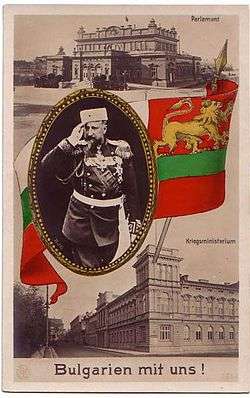
|

